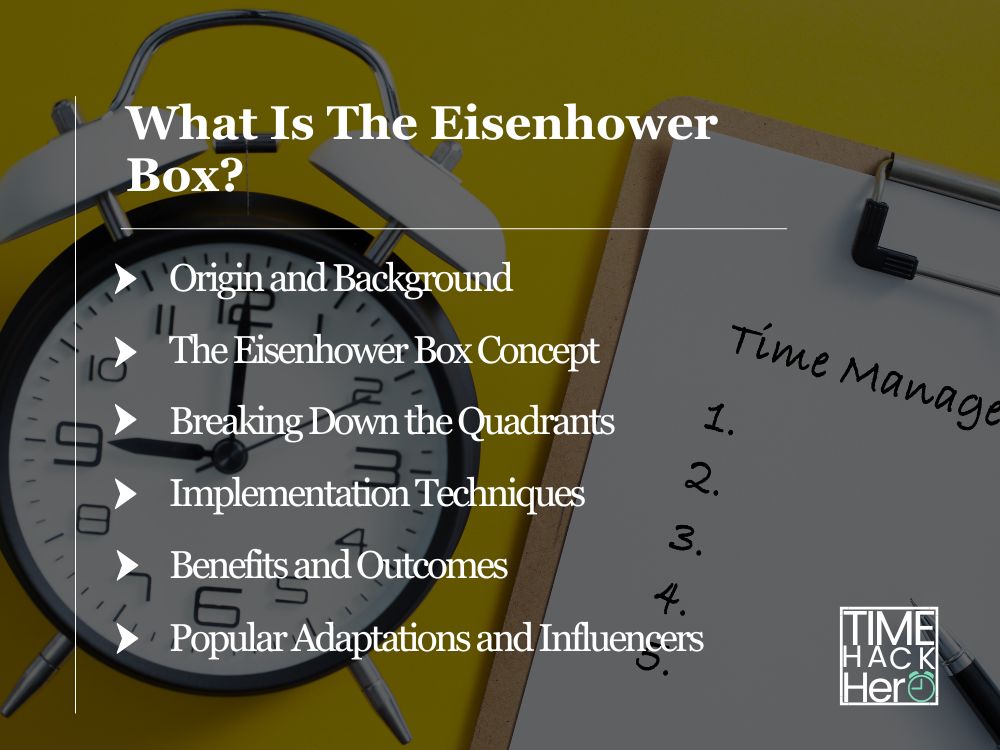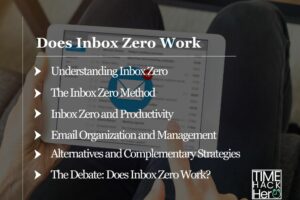Are you struggling with managing your time and prioritizing tasks effectively? If so, the Eisenhower Box might be the perfect tool for you. This simple, yet powerful time management method was developed by Dwight D. Eisenhower, the 34th President of the United States, who was known for his incredible ability to make decisions and stay organized amidst a busy schedule.
The Eisenhower Box, also known as the Eisenhower Matrix or the Urgent-Important Matrix, is a prioritization framework designed to help you sort through the noise and make well-informed choices on which tasks to focus on first. By categorizing your to-do list items into four distinct boxes based on their urgency and importance, you’ll find it much easier to decide what to tackle immediately, what to schedule for later, what to delegate, and what to eliminate altogether.
As you continue to embrace the Eisenhower Matrix in your everyday life, you’ll begin to notice improvements in your productivity and overall time management skills. Say goodbye to the constant feeling of being overwhelmed, and hello to a more structured and efficient approach to tackling your tasks.
Table of Contents
Origin and Background
Dwight D. Eisenhower, 34th President of the United States
Dwight D. Eisenhower was the 34th President of the United States, serving two terms from 1953 to 1961. Before becoming president, he was a Five-Star General in the United States Army and played a significant role in World War II as the Supreme Allied Commander in Europe. During his presidency, Eisenhower introduced many initiatives and policies that led to the development of major institutions and infrastructures.
Five-Star General
As a Five-Star General, Eisenhower displayed incredible leadership abilities in organizing and strategizing military operations. He led the invasion of Normandy in 1944, which was a crucial operation for the Allied forces during World War II. His skills in decision-making, prioritization, and organization became crucial factors not only in his military career but also during his time as the President.
Interstate Highway System
One of Eisenhower’s most significant accomplishments as President was the establishment of the Interstate Highway System. He signed the Federal-Aid Highway Act in 1956, which facilitated the construction of a network of over 41,000 miles of controlled-access highways across the United States. This system connected cities and states, leading to easier transportation, increased commerce, and economic growth.
NASA
The establishment of the National Aeronautics and Space Administration (NASA) in 1958 was another major achievement during Eisenhower’s presidency. He recognized the importance of space exploration and research, resulting in the United States becoming a key player in the global space race. NASA went on to conduct groundbreaking missions, including the Apollo moon landing in 1969.
DARPA
During his presidency, Eisenhower also established the Defense Advanced Research Projects Agency (DARPA) in 1958. This agency focuses on developing emerging technologies to maintain and advance the United States’ military capabilities. Some of DARPA’s key achievements include the creation of the early internet (ARPANET) and the development of stealth technology.
Atomic Energy Act
In 1954, Eisenhower signed the Atomic Energy Act, which amended the earlier McMahon Act of 1946. Among other things, this legislation allowed for the development of nuclear power for civilian use and opened the door to international cooperation for peaceful nuclear technology purposes.
The Eisenhower Box, named after President Dwight D. Eisenhower, is a time management and decision-making tool influenced by his skills in prioritizing and organizing tasks. By using the Eisenhower Box, you can sort tasks into four categories based on their urgency and importance. This method helps to focus on what matters most and allocate your time and resources more effectively.
The Eisenhower Box Concept
The Eisenhower Box, also known as the Eisenhower Matrix, is a time management approach you can use to prioritize your tasks and responsibilities based on urgency and importance.
Quadrants
To start using the Eisenhower Box, you’ll need to divide your tasks into four quadrants. Each quadrant has a distinct combination of urgency and importance:
- Urgent and important: These are tasks that require immediate attention and directly impact your goals. They should be completed right away.
- Important, but not urgent: These tasks can wait but still contribute to your objectives. Schedule time to complete them later.
- Urgent, but not important: Delegate these tasks to someone else, if possible. They require prompt action but don’t significantly affect your overall success.
- Not urgent and not important: Minimize or eliminate these tasks from your to-do list. They consume time without providing real value.
| Quadrant | Urgency | Importance |
|---|---|---|
| 1 | Yes | Yes |
| 2 | No | Yes |
| 3 | Yes | No |
| 4 | No | No |
Urgency
Urgency refers to how swiftly a task or responsibility must be addressed. When assessing the urgency of your tasks, consider factors like deadlines, time-sensitive opportunities, and potential consequences of failing to complete them promptly. Urgent tasks typically demand action right away, while non-urgent tasks can be scheduled for later completion.
Importance
Importance, on the other hand, relates to the significance a task holds for your goals and overall success. Some tasks can have a major impact on your progress, making them important. Others might possess urgency without being crucial for your success and should be delegated or minimized in your priority list.
By combining these two dimensions—urgency and importance—you can better prioritize your tasks and manage your time efficiently, ultimately improving your productivity and effectiveness in achieving your goals.
Breaking Down the Quadrants
Urgent and Important
In the Eisenhower Matrix, the first quadrant is labeled as “Urgent and Important.” These are tasks that require immediate attention and have a significant impact on your life or work. Examples of such tasks may include approaching deadlines, crisis situations, or medical emergencies. To effectively manage these tasks:
- Prioritize them over other tasks.
- Allocate sufficient time and resources to address them.
- Focus on completing them before moving to other quadrants.
Important, But Not Urgent
The second quadrant consists of tasks that are “Important, but Not Urgent.” These tasks are crucial for long-term success and personal growth but may not have immediate consequences if left unaddressed. Examples may include exercise, personal development, or networking opportunities. To handle these tasks:
- Schedule regular time for them, balancing your short-term priorities.
- Set deadlines for these tasks to create a sense of urgency.
- Keep track of progress and regularly reassess their importance.
Urgent, But Not Important
The third quadrant contains tasks that are “Urgent, but Not Important.” These tasks demand immediate attention but may not contribute significantly to your long-term goals or personal growth. Examples may include certain emails, phone calls, or social media notifications. To manage these tasks:
- Consider delegating them to others, if possible.
- Address them quickly and efficiently to avoid consuming too much time.
- Set boundaries to minimize their disruption to your more important tasks.
Neither Urgent Nor Important
Lastly, the fourth quadrant comprises tasks that are “Neither Urgent nor Important.” These tasks may have little to no impact on your overall productivity or personal growth. Examples might include mindless browsing or certain recreational activities. When dealing with these tasks:
- Limit the time spent on them to avoid distraction from more important tasks.
- Reevaluate whether they should be part of your daily life.
- Use them as occasional breaks or rewards for completing higher-priority tasks.
Implementation Techniques
Prioritizing Tasks
To make the most of the Eisenhower Box, start by categorizing your tasks into four quadrants:
- Urgent and important: Tasks that require immediate attention and contribute to your long-term goals. These are the tasks you should focus on first. Examples include meeting deadlines, dealing with emergencies, and resolving critical problems.
- Important but not urgent: Tasks that are important but can be scheduled for later. These should be planned and allocated time to ensure they are completed before they become urgent. Examples include strategic planning, professional development, and relationship building.
- Urgent but not important: Tasks that require immediate attention but do not contribute to your long-term goals. These tasks should be delegated whenever possible. Examples include responding to non-essential emails, attending unproductive meetings, and handling interruptions.
- Neither urgent nor important: Tasks that can be eliminated or minimized in your schedule. These tasks do not contribute to your goals and take up valuable time. Examples include watching excessive TV, browsing social media, and engaging in gossip.
Delegating Tasks
Delegation is a key aspect of effectively using the Eisenhower Box. When you identify tasks that are urgent but not important, it’s essential to delegate them if possible. By doing so, you free up time to focus on the tasks that are important and contribute to your long-term goals.
In order to delegate tasks effectively:
- Clearly communicate the task, expectations, and deadline to the person taking over.
- Provide any necessary resources or support to ensure successful completion.
- Regularly follow up to ensure the task is on track and ask if any help is needed.
Eliminating Distractions
The Eisenhower Box highlights the importance of time management by helping you identify tasks that do not contribute to your long-term goals. To make the most of your time, eliminate or minimize distractions whenever possible:
- Set boundaries and limit interruptions, such as minimizing phone notifications or designating specific times for checking email.
- Create a dedicated workspace free of unnecessary distractions.
- Establish routines and rituals that help you stay focused, such as listing daily priorities and taking breaks when needed.
Scheduling Time
Effective time management goes hand in hand with the Eisenhower Box. Once you’ve categorized your tasks, schedule time to work on the important tasks that require your attention:
- Allocate time in your calendar for urgent and important tasks, as well as those that are important but not urgent.
- Prioritize your tasks by focusing on the most important and urgent first, followed by important but not urgent tasks.
- Ensure you set realistic deadlines for each task to maintain a manageable workload.
Benefits and Outcomes
Improved Productivity and Efficiency
The Eisenhower Box, also known as the Urgent-Important Matrix, can significantly improve your productivity and efficiency. By categorizing your tasks according to urgency and importance, you can prioritize and tackle them in a more organized manner. This helps you focus on tasks that truly matter, which in turn maximizes your efficiency and productivity:
- Urgent and important tasks get immediate attention
- Important, but non-urgent tasks can be scheduled for later
- Non-important, but urgent tasks can be delegated
- Non-important, non-urgent tasks can be eliminated
This structured approach ensures that your time and energy are invested in the right tasks.
Reduced Stress and Burnout
Applying the Eisenhower Box can help reduce stress and prevent burnout. As you prioritize tasks and allocate your time effectively, you can avoid being overwhelmed by a seemingly endless to-do list. Moreover, by eliminating or delegating non-essential tasks, you free up time for yourself, giving you the opportunity to recharge and maintain a healthy work-life balance. The systematic prioritization of tasks can provide you with a sense of control and accomplishment, ultimately reducing stress levels.
Enhanced Decision-Making
The Eisenhower Box aids in refining your decision-making skills. By continually assessing the urgency and importance of your tasks, you become better at making quick, informed decisions about where to allocate your time and resources efficiently. This practice trains your mind to be more decisive in general, resulting in improved decision-making in all aspects of life.
In conclusion, the Eisenhower Box offers numerous benefits, including improved productivity and efficiency, reduced stress and burnout, and enhanced decision-making. By implementing this simple yet effective tool, you can optimize the way you manage your tasks and make the most of your time.
Popular Adaptations and Influencers
Stephen Covey’s Time Management Matrix
Stephen Covey, author of The 7 Habits of Highly Effective People, popularized the Eisenhower Box by adapting it into his Time Management Matrix. This matrix helps you prioritize tasks based on urgency and importance, guiding you to focus on what truly matters. Covey’s concept of “First Things First” resonates with the Eisenhower Box, emphasizing the need to prioritize and attend to the most important tasks first.
The Time Management Matrix is divided into four quadrants:
- Important and Urgent: Tasks that must be done immediately
- Important, Not Urgent: Tasks that can be scheduled for later
- Urgent, Not Important: Tasks that can be delegated
- Not Urgent, Not Important: Tasks that can be eliminated
By categorizing your tasks this way, you can allocate your time and energy more efficiently.
Tim Ferriss’ Annual Review and Integrity Report
Tim Ferriss, a well-known author and entrepreneur, also incorporates aspects of the Eisenhower Box in his productivity and time management strategies. He recommends conducting an Annual Review, a personal audit of your life and goals, to evaluate and prioritize tasks that align with your objectives. Ferriss also suggests developing an Integrity Report to assess personal values and how they are reflected in your actions. By combining the Eisenhower Box with these reflective exercises, you can ensure that your priorities align with your long-term goals and values.
Brett McKay’s Eisenhower Decision Matrix
Brett McKay, the founder of The Art of Manliness website, created his adaptation called the Eisenhower Decision Matrix. In this version, the Eisenhower Box is transformed into a matrix with more detailed categories. The Eisenhower Decision Matrix consists of the following:
- Must Do: Important and urgent tasks that need immediate attention
- Plan: Important but not urgent tasks to schedule for later
- Delegate: Tasks that can be delegated to others because they are urgent but not important
- Eliminate: Tasks that are neither important nor urgent and can be removed
This adaptation helps you make more informed decisions when prioritizing your tasks while still staying true to the core principles of the Eisenhower Box. Ultimately, the Eisenhower Box and its various adaptations are powerful tools for managing your time and prioritizing tasks to achieve success and maintain focus.
Conclusion
In summary, the Eisenhower Box is a highly effective time management tool that can assist you in prioritizing tasks and making better decisions. By categorizing tasks into four quadrants based on their urgency and importance, you can focus on what truly matters and avoid getting overwhelmed with a never-ending to-do list.
To get started with the Eisenhower Box, begin by listing all of your tasks and categorizing them into the four quadrants:
- Urgent and important: These are tasks that require immediate attention and directly impact your goals. Prioritize and tackle these tasks first, as they are crucial for success.
- Important, but not urgent: Schedule time in your day or week to address these tasks. They are valuable for long-term success but do not need to be completed immediately.
- Urgent, but not important: Delegate or automate these tasks if possible. They are time-sensitive but do not directly align with your goals.
- Neither urgent nor important: Consider eliminating or reducing time spent on these tasks as they do not contribute significantly to your goals.
Remember, consistency is key to effectively utilizing the Eisenhower Box. Make it a daily habit to evaluate your tasks within the matrix and continuously adjust your priorities. Over time, you’ll become more efficient and effective in managing your workload and achieving your goals. Give the Eisenhower Box a try, and experience the benefits of a well-organized and prioritized life.









